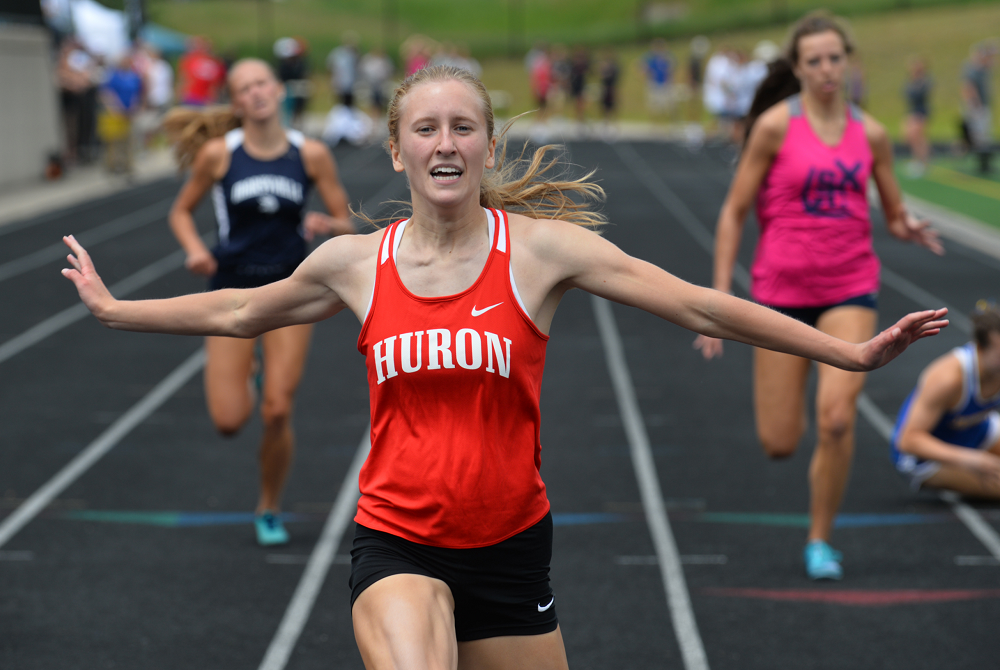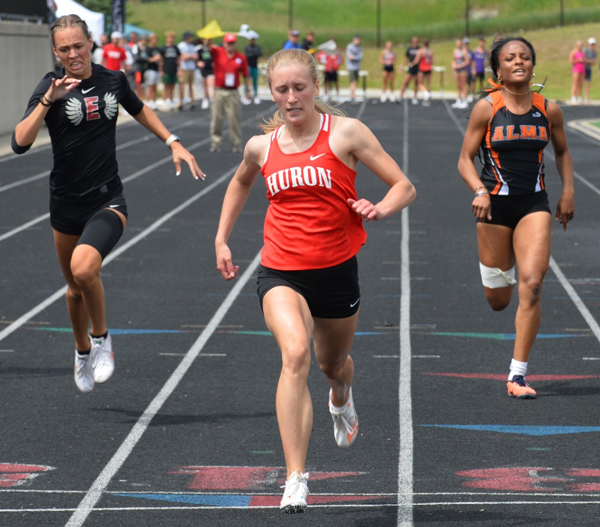
Saints Shine Across Board in UPD2 Repeat
By
John Vrancic
Special for MHSAA.com
June 3, 2018
KINGSFORD — The St. Ignace girls placed in all 17 events Saturday, repeating as Upper Peninsula Division 2 track champions with 160 points.
Runner-up Iron Mountain scored 90 and Ishpeming placed third at 75.
St. Ignace junior Libby Becker won the 800-meter run in 2 minutes, 24.5 seconds, 1,600 (5:23.52) and 3,200 (11:56.41) and helped the winning 1,600 relay (4:24.82).
“I just wanted to do my best,” she said. “I wanted to PR. But if I didn’t, that’s okay too. I love these conditions. The breeze helped out a lot. It’s hard to run in dead heat.”
Junior Emily Coveyou, also a part of the 1,600 relay, added a first in the 400 (1:04.11) and was runner-up in the 100 (13.56) and 200 (27.73) on this sunny and mild day.
“That wasn’t my best time in the 400,” said Coveyou, who was battling a chest cold. “My starts were better today than usual, but it was harder for me to breathe.”
The Saints started the day by squeezing past Manistique for the 3,200 relay title. They were clocked at 11:04.29, edging the Emeralds by two hundredths of a second.
“Four different girls tried out for the 3,200 relay and it took a while to find the right combination,” said senior Caitlin Dean. “We just tried to keep pace with Manistique. It was exciting when Allison (Smith) went ahead for a while.”
A first trip to the Finals provided plenty of motivation for Saints’ freshman Hallie Marshall, who also helped the 3,200 relay.
“This is the last day of track,” said Marshall, who was also runner-up in the 3,200 (12:54.14) and third in the 1,600 (5:50.28). “I just practiced real hard for this. I’m really excited to be here.
“Our (3,200 relay) team really improved at the Regional (May 18 at Manistique). After finishing so close to Manistique in the Regional, we knew we had a chance.”
 Freshman Emmalee Hart placed second in the 800 (2:30.74), shared second with teammate Jessie Frazier in pole vault (7-6) and helped the 1,600 relay.
Freshman Emmalee Hart placed second in the 800 (2:30.74), shared second with teammate Jessie Frazier in pole vault (7-6) and helped the 1,600 relay.
“It felt great to end the day with a W,” said Hart. “It was a great effort by everybody. It’s nice to have a competitive team. Our seniors show us what we need to do to reach that point.”
St. Ignace senior Linnee Gustafson captured high jump for the fourth straight year at 4-11.
“That was definitely not my best jump, but I’ve been jumping around that height all year,” said Gustafson, who will play basketball at Northwood University next winter. “I just wanted to win it four years in a row. I wasn’t concerned about the height as much as the place.”
The Saints also got a first from Heather Lamb in long jump (14-8½).
Saints coach Trudy Olsen was understandably happy with the team’s effort.
“All the girls did good,” she said. “Linnee winning high jump four years in a row was real special. She works hard the year around. Emily did a great job considering she wasn’t feeling the best. Libby works real hard. That was an amazing performance by her.”
Iron Mountain’s Taylor Talerico won the 100 (13.45), with Olivia Berutti taking the 200 (27.72) and both helping the winning 400 relay (52.76).
Ishpeming’s Katie Loman won the 100 hurdles (16.55), and Berutti was runner-up (16.64). Loman (48.88) won the 300 hurdles just ahead of Talerico (49.34).
Iron River West Iron County had a double-winner in senior Rachael Tefft, who took shot put (36-6½) and discus (112-7).
PHOTOS: (Top) St. Ignace’s Libby Becker sets the pace in a relay Saturday. (Middle) Ishpeming’s Katie Loman, left, and Iron Mountain’s Taylor Talerico clear the final hurdles in the 300. (Photos by Cara Kamps. Click for more at RunMichigan.com.)

Multi-Sprint Champ Racing to Finish Huron Career Ahead of the Rest Again
By
Keith Dunlap
Special for MHSAA.com
May 25, 2023
NEW BOSTON – If there was one thing Elizabeth Anderson took pride in elementary school, it was simply showing that she could outrun everyone in sight.
 In fact, Anderson has an explanation for all the success she had in those playground races.
In fact, Anderson has an explanation for all the success she had in those playground races.
“Dominance when you are in elementary school,” Anderson quipped. “I don’t think I ever had a nickname. I just think everyone knew I was fast.”
Years later, pretty much everyone who follows track & field in the state of Michigan can attest to that.
A senior for New Boston Huron, Anderson has been faster than most other competitors in the state during her three-year high school career (with her freshman season in 2020 canceled due to COVID-19).
Last year, Anderson won titles at the Lower Peninsula Division 2 Finals in the 200-meter (25.07) and 400-meter (56.28) dashes, and was runner-up in the 100-meter dash (12.23).
Often, top sprinters focus on one or two of those three races. But Anderson is certainly a different breed of sprinter because she does all three.
In fact, she holds school records in all three of those events, and if all that weren’t enough, Anderson is a part of all three sprint relay teams.
“It is hard to give her events off,” said New Boston Huron head girls track coach Danielle Lobato.
Despite the different styles the 100, 200 and 400-meter dashes present, Anderson said there usually isn’t much adjusting when she goes from one of those races to another.
 The strategy is simply, “Let’s beat the other girls to the finish line.”
The strategy is simply, “Let’s beat the other girls to the finish line.”
“I don’t really go into each race changing up how I would run,” she said.
While enjoying and succeeding in all three races, Anderson said she actually does have a favorite among them.
“I would say the 400 is probably my favorite,” she said. “Even though it hurts, it’s satisfying to see how much you can get your time down in the 400 compared to any other race.”
Anderson said she started running track in sixth grade, but really got serious about it during the summer after her sophomore season, when she was invited to run for a local club.
Eventually, that led to her competing over the winter in indoor events.
She lived and breathed track so much that last fall, she decided to not run cross country so she could focus on a weightlifting regimen aimed at developing more leg strength.
“Once I started doing summer track, I realized I wanted to be doing this all the time,” she said.
Lobato said oftentimes in practice, Anderson is a de facto coach, given there is no better person she can think of for the younger runners on the team to learn from.
“I can’t always demonstrate these things I’m trying to teach,” she said. “You get to see it in real life (from Anderson), not in a YouTube video.”
After winning the 100, 200 and 400-meter dashes at her Regional meet last week, Anderson has her sights set on achieving the same trifecta of titles at next Saturday’s Finals in Grand Rapids.
Anderson has signed to run track at Michigan State, but has been plenty motivated to keep producing this spring in her final high school season.
“I’m really looking to defend my titles,” she said. “That is what is really motivating me to keep going. I want to keep in shape for the college season. I don’t want to lose any of the progress I have made. Ultimately, I just love running track.”
And since elementary school, Anderson has loved — and succeeded in — outrunning everyone else to the finish line.
“We knew we were getting something special,” Lobato said of when Anderson arrived in high school. “But you never expect this. All that she has accomplished is amazing.”
 Keith Dunlap has served in Detroit-area sports media for more than two decades, including as a sportswriter at the Oakland Press from 2001-16 primarily covering high school sports but also college and professional teams. His bylines also have appeared in USA Today, the Washington Post, the Detroit Free Press, the Houston Chronicle and the Boston Globe. He served as the administrator for the Oakland Activities Association’s website from 2017-2020. Contact him at [email protected] with story ideas for Oakland, Macomb and Wayne counties
Keith Dunlap has served in Detroit-area sports media for more than two decades, including as a sportswriter at the Oakland Press from 2001-16 primarily covering high school sports but also college and professional teams. His bylines also have appeared in USA Today, the Washington Post, the Detroit Free Press, the Houston Chronicle and the Boston Globe. He served as the administrator for the Oakland Activities Association’s website from 2017-2020. Contact him at [email protected] with story ideas for Oakland, Macomb and Wayne counties
PHOTOS (Top) New Boston Huron's Elizabeth Anderson clears the finish line during last season's LPD2 400 race. (Middle) Anderson, middle, outpaces the field to also win the 200. (Click for more from RunMichigan.com.)

